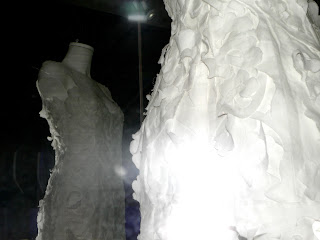Dress piece - Madras (chennai), india 1882 / Silver, silk, spangles & beetle wings
Kincob - Benares (varanasi), India 1850 / silk
Kincob - Benares (varanasi), India 1850 / silk
Sari - Benares (varanasi), India 1850 / silk
Blouse piece - Bombay (Mumbai), India - Early 19th century / Embroidered Satin
Indian textiles have a long and prestigious history. Unlike in Europe during the 18th century, Indians had very fine cotton- lighter and softer then the European linen – printed cotton ‘chintz’ (spotted) with bright colors that could be washed, woven cashmere, and unique patterns.
As we could see at the exhibition, they were often inspired by nature. Many of their patterns featured trees, animals, birds, marine creatures, and their patterns were based on flowers and leaves. But they also had great techniques, for example, mordant dyeing which gives the fabric an intense color not to fade.
Europeans were very interested in those fabrics. They traded them in Asia- for spices, coffee, and tea- and in Africa- for gold and ivory-
They were luxurious good, as well as washable substitutes for other European textiles.
India had great merchandise, but still tried to adapt their goods according to every market. For example, they created textiles based on French poetry for the French market. In 1800 they remodeled to the neoclassical style, and exported muslin and Kashmir shawls that were produced into neoclassical clothing and interiors.
“India was to become the greater exporter of textiles the world had ever known.”
However, after the 1770, Britain overtook India as a major exporter of printed cotton cloth, and was not just self-sufficient, but also exported to India.
picture taken from http://www.vam.ac.uk/collections/asia/asia_features/indian_textiles/objects/index.php





































